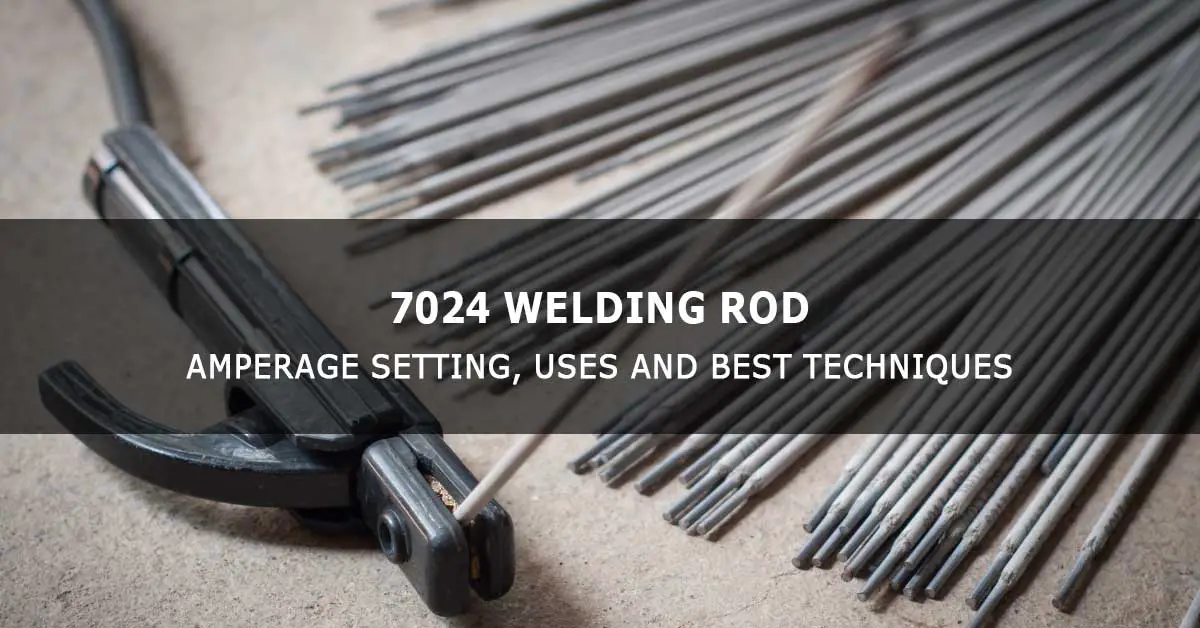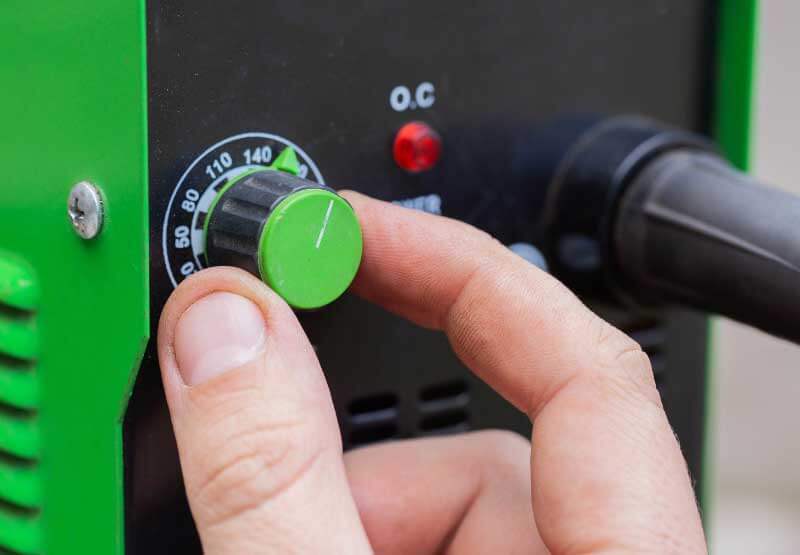The 7024 welding rod is one of the most commonly used rods in the welding industry. However, many welders struggle to use it correctly due to a lack of knowledge on its amperage setting, best techniques, and uses. E 7024 welding rod is a high weld metal deposition and shallow to medium penetration rod designed only for flat and horizontal welding positions.
In this article, we will walk through everything you need to know about 7024 welding rods: from amperage settings and proper use techniques to some of the best ways to get the job done precisely. So strap on your helmet, and let’s dive into what makes 7024 rods great!
Brief about 7024 welding electrode
The code of the E7024 stick welding electrode means the following, as per the American Welding Society standard:
E-Electrode for shielded metal arc welding (SMAW) or stick welding process.
70– Indicates the minimum ultimate tensile strength as 70,000 psi. (Minimum yield strength is 58,000 psi. The elongation percentage is 17 %.).
2-This welding rod can only be used for welding in flat and horizontal positions.
4-This refers to the coating type ‘Iron powder, Titania,’ which can be used with the current DCEN, DCEP, and AC. However, most electrode manufacturers recommend using 7024 with AC or DCEN only.
Chemical composition of E 7024
| Chemical composition of E 7024 | ||
| Carbon-0.15% max | Chromium-0.2% max | Manganese-1.25% max |
| Molybeenum-0.3% max | Nickel-0.3% max | Phosphorous-0.035% max |
| Silicon-0.9% max | Sulfur-0.035% max | Vanadium-0.08% max |
Few welding parameters for E 7024 electrode
| Few welding parameters for E 7024 electrode | |||
| Welding rod diameter in inches | Type of current | Amperage range | Voltage range |
| 1/8ʺ | DCEN or AC | 130-150 | 26-27 |
| 5/32ʺ | DCEN or AC | 180-225 | 26-28 |
| 3/16ʺ | DCEN or AC | 200-280 | 26-28 |
7024 electrode is a fast-fill coated electrode with a high weld metal deposition rate and welding speed. Due to these qualities of the 7024 rod, many welders call this a ‘Jet’ rod; in fact, one welding rod manufacturer markets the 7024 rod as a ‘Jet rod.’
The characteristics of the 7024 rods
- The heavy flux coating on the 7024 rods has a high iron powder content, and the weight of the coating amounts to 50% of the total weight of the rod. The iron powder in the heavy flux coating contributes to this welding rod’s higher deposition efficiency, and the weld face can be a bit convex or flat with a good and smooth surface with fine ripples.
- 7024 rod is not a low hydrogen electrode; however, the electrode manufacturer recommends that once the packet is opened, the rod should be stored between 60° F and 100° F and below 50% relative humidity or stored in a drying oven between 100° F and 120° F. The rods can be reconditioned in a drying oven for one hour between 250° F and 300° F.
- The 7024 rod is designed for use in flat welds and horizontal position welding only, and this rod creates a big molten weld puddle that is a bit slow in solidification. Use it in places where a big and smooth weld bead is required.
- 7024 is a drag rod normally used for high-weld metal deposition stringer weld beads.
- The 7024 rod exhibits a smooth, quiet welding arc, low arc penetration, and fewer spatters. The 7024 rods work well with AC or DCEN and are a good choice for structural fabrication, plate welding, shipbuilding, trailers, railroad carriages, earth-moving machinery, mining machinery, etc.
- Welders prefer to use 7024 electrodes with AC for single or multi-pass welding, and the reason is a good welding arc.
- Due to their high deposition rate and welding speed, many welders prefer using 7024 rods for butt welds (flat position) and fillet welds. 7024 performs well when the thickness of the steel plate (base metal) is 1/4ʺ and more.
- 7024 is a shallow to medium penetration rod and gives a smooth weld with easily removable slag.
- Some welders do not prefer 7024 since it is not an all-position rod, and slag can be included due to the heavy coating.
- 7024 rod can also be used in horizontal position welding, but when used on grooved horizontal joints, the high welding speed does not allow sufficient time for the molten weld metal to cool under the thick flux coating. Due to this reason, 7024 is normally used only on lap/fillet weld joints in the horizontal position (the molten weld metal has support and is not left to gravity).
- 7024 rods are normally used for heavy weld beads, and you may find it difficult to procure rods of less than 1/8ʺ mm diameter.
- The high deposition rate of the 7024 rod makes the welding easy as long as the ampere is set correctly. A slightly more advanced angle drag technique can help the welder push the slag back.
7024 Welding rod amperage setting, uses, and best techniques
Amperage setting
Correct amperage setting is important in making the weld good or bad. A wrong ampere setting can lead to welding defects like a spatter, slag inclusion, bad quality weld beads, etc. 7024 rods require comparatively high ampere (heat input).
The ampere setting for a welding job depends on the recommended ampere range for the electrode diameter and base metal thickness. For higher base metal thickness, a higher diameter of welding rod is used, and a higher diameter of welding rod needs a higher ampere to melt the electrode and the coating.
The advice of experienced welders that a welder should never use a welding rod whose diameter is more than the base metal thickness also applies to the 7024 rods.
The link between the welding rod diameter, base metal thickness, and amperage
Due to its very high weld metal deposition rates, welders normally prefer to use 7024 rods for welding base metal thickness of 1/4ʺ mm and above. Every welding rod manufacturer prints the suggested ampere range on the packing label for the diameter of the welding rod packed in it. This is a good reference.
A table of electrode diameter and suggested ampere range is compiled and placed above. You will notice that the suggested ampere range increases with the increase in the diameter of the rod, and the reason are obvious since the higher diameter of the rod requires higher heat (ampere) to melt. Selecting the correct amperage comes with the welder’s experience; however, since the 7024 rods are normally used for flat-position welding, selecting the amperage is not very difficult (even for beginners). Please refer to the table of welding rod diameter v/s suggested ampere range or the box of the welding rod and note down the recommended ampere range for the selected welding rod diameter.
Set the amperage at the lower range and increase it in small increments till you achieve the correct ampere for the job. The correct ampere may be nearer to the average of the minimum and maximum of the ampere range (for example, the suggested ampere range for a 3/16ʺ diameter rod is 200 to 280, and the average range is 240 amperes). Even after doing the above exercises to arrive at the correct amperage, there can still be the problem of a very high or very low amperage setting. How do you know if the amperage set is correct, very low, or very high? Let us discuss this.
The effect of a low amperage setting can be:
- Non-uniform and ugly-looking weld bead.
- Difficulty in striking the arc.
- The rod does not melt fast, resulting in reduced welding speed and reduced weld metal deposition rate.
The effect of a high amperage setting can be:
- Spatter and slag inclusion.
- It becomes difficult to control the high molten weld metal puddle.
- The rod becomes red hot, and the flux coating may fall off.
- The weld bead becomes wider.
- Welding speed must be increased to keep up with the molten weld puddle.
Techniques
- The optimum current for most of the welding jobs with 7024 rods is around 5 amperes more than the average of the suggested ampere range; however, for X-ray quality weld beads, it may be good to follow the average of the suggested amperage range for the electrode diameter.
- Use alternating current (AC) for high weld metal deposition, faster welding speeds, and good welding arc. You can use direct current (DCEN), but the arc blow makes controlling the molten weld puddle difficult and complicated.
- 7024 rod works well with the drag technique, tipping the electrode slightly in the direction of weld travel (10° to 25°) for stringer beads.
- 7024 rod allows high welding speed, but the optimum speed can be staying a little ahead of the molten slag (around 1/4ʺ). If the welding speed is slow, a small amount of slag can flow ahead of the welding arc, and this can cause welding defects (spatter, shallow penetration, ugly bead shape, etc.).
- When welding deep groove butt welds, use a backing plate and a stringer or weave weld metal deposition technique to create a good fusion of the base metals. The backing plate helps to hold the large molten weld metal pool. Without a backing plate, a root pass can be made using a deep penetration electrode before using the 7024 rods.
Conclusion
E7024 welding rods are an excellent choice for welding thick materials with heavy weld beads, such as steel plates and structural steel. Welders prefer to use 7024 rods due to their good weldability and superior mechanical properties.
Whether you are a professional welder or a DIY enthusiast, understanding the proper use and techniques of 7024 welding rods can help you achieve high-quality welds that will stand the test of time. We hope that the information in this article is helpful to you!
Continue Reading: A Guide To 6010, 6011, 6013, And 7018 Welding Rods.
References








